By Todd McLeish
URI’s connection with Mystic Aquarium affords one-of-a-kind opportunities for URI students and alumni.
The University of Rhode Island and Mystic Aquarium, in nearby Mystic, Connecticut, have forged a special relationship. At Mystic Aquarium, you’ll find URI alumni in a variety of roles and URI students working on internships. There’s an upper-level undergraduate seminar on marine mammals taught at the aquarium, and a URI faculty member doing important research on beluga whale reproduction. Ask any of them what they love about their work at Mystic, and they’ll tell you it’s the exposure to the animals and the one-of-a-kind chance to do rewarding work.
Dream Job
When Allie Seifter Bruscato ’11 was a child growing up in Brooklyn, she often visited the New York Aquarium, and she quickly decided that she wanted to pursue a career as a marine mammal trainer. It’s why she decided to study marine biology at the University of Rhode Island.
As a student at URI, she dived in Honduras with the Scuba Club and researched stingrays and endangered North Atlantic right whales. After graduation, she worked as a marine mammal observer on an icebreaker off the coast of Alaska, in small planes off the Georgia coast, and on a dredge off the New Jersey coast. Her desire to work with marine mammals never waned.
She eventually landed her dream job at Mystic Aquarium’s Arctic Coast and Pacific Northwest exhibit. She spends every day with beluga whales, harbor seals, Steller sea lions and northern fur seals. She couldn’t be happier.
“It’s so great to be here,” Bruscato said. “It takes a lot of hard work to get here, there’s a lot of competition, and it definitely takes a lot of dedication to make sure everything runs smoothly for the animals. And a lot of teamwork. But I’ve been here for five years and hope to continue my career here.”
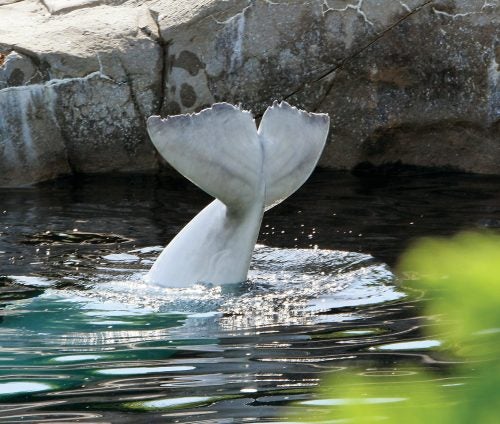
Photo: Courtesy Mystic Aquarium
Bruscato is one of many URI students, faculty, and alumni who have benefited from a unique partnership between URI and Mystic Aquarium. Some have enrolled in a URI class taught entirely at the aquarium, while others have conducted research there or served as interns in any one of a dozen different aquarium departments. A lucky few—today that number is eight—work as permanent employees who care for the animals, educate the public, and ensure that visitors have the best experience possible.
Five URI alumni serve as marine mammal trainers at Mystic: Bruscato, Jen Rock ’06, Lindsey Nelson ’06, Alycia Coulumbe ’16, and Rachael DesFosses ’15.
In most cases, the animals are not trained to perform or entertain guests. Instead, trainers help the animals learn how to work with staff and veterinarians who are responsible for monitoring their health. For example, Bruscato spent time this winter and spring helping a 19-year-old harbor seal learn how to get an X-ray.
“I’m responsible for all of his husbandry behaviors, his diet, and his overall health care,” Bruscato says. “Now he knows how to go on the radiograph plate and he allows our vets to scan his body with a light. He’s ready for that procedure whenever he needs it.”
The Coolest Class
Most URI students who get to experience Mystic Aquarium behind the scenes do so when they enroll in Seminar on Marine Mammals (AVS 440), an upper-level course held entirely at the aquarium. The class was first taught more than 35 years ago in collaboration with the University of Connecticut, but today more than 90 percent of the students enrolled are from URI, primarily those majoring in marine biology and animal science. Co-taught by postdoctoral fellow Justin Richard, Ph.D. ’16, who worked at the aquarium as a beluga whale trainer before earning his doctorate at URI, and Mary Ellen Mateleska, director of conservation programs at the aquarium, it features weekly guest speakers from around the country discussing such topics as dolphin communication, marine mammal stranding and rehabilitation, dive physiology, and aquarium veterinary care.
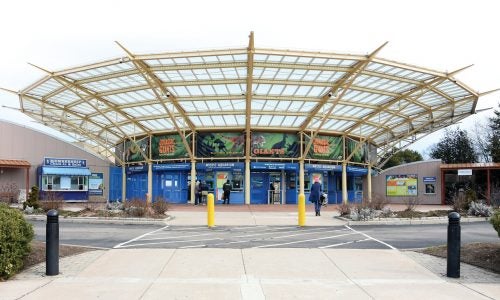
Robert Kenney, Ph.D. ’85, emeritus marine scientist at URI’s Graduate School of Oceanography, has led one class session each year since 1983, focusing on whale bioenergetics and feeding strategies. In his sessions, he draws on his decades of experience studying right whales.
According to Richard, one theme of his class is applying scientific literature to the field of marine mammal biology.
“My biggest role is overseeing the assignments where students are challenged to dig into the scientific literature and learn how to evaluate articles and understand how they can be applied to marine mammal conservation and management,” he says.
In addition to the weekly lectures, students get a behind-the-scenes tour of the aquarium and go on a whale watch.
“That class was the coolest thing I did at URI,” says DesFosses. “All the different speakers gave such an interesting perspective about the field, and I just soaked it all in. It helped me confirm that working with marine animals was what I really wanted to do.”
Kaitlyn Quirke ’18 had a similar reaction to the class.
“It’s definitely not an overstatement to say that the class changed the entire trajectory of my career,” she says. “I was a marine bio major, but I wasn’t sure what I was going to do with it. And when the class brought in all these different professionals from the field, it showed me that there’s so many directions you can take with a career in marine mammals. I molded the rest of my education around that one class.
“We got to see so much of what goes on behind the scenes at the aquarium and how to apply what we were learning in class,” she adds. “We felt like VIPs one night a week.”
Before the end of their respective classes, Richard invited DesFosses and Quirke to help him with his research on beluga whale reproductive physiology, and he advised them to join the volunteer program at the aquarium, which gave them a competitive advantage when applying for the aquarium’s highly competitive internships.
Seal the Deal
“I think what made me stand out during my internship interview was that I was willing to volunteer first,” Quirke said. “I proved during my volunteer time that I’m reliable and a hard worker, so
they knew that about me going in.”
Quirke’s internship in guest services and the marine mammal husbandry department—which includes working with a harbor seal—continues through August 2019. And then she has her fingers crossed that she will get hired to work with animals or in another public outreach role.
DesFosses completed three internships at the aquarium before she was hired full-time, but she says it was all worthwhile. “It’s the coolest job; it’s everything I could have imagined it would be and more,” she says. “I don’t think I could ever want anything more with my career than what I’m doing now.”
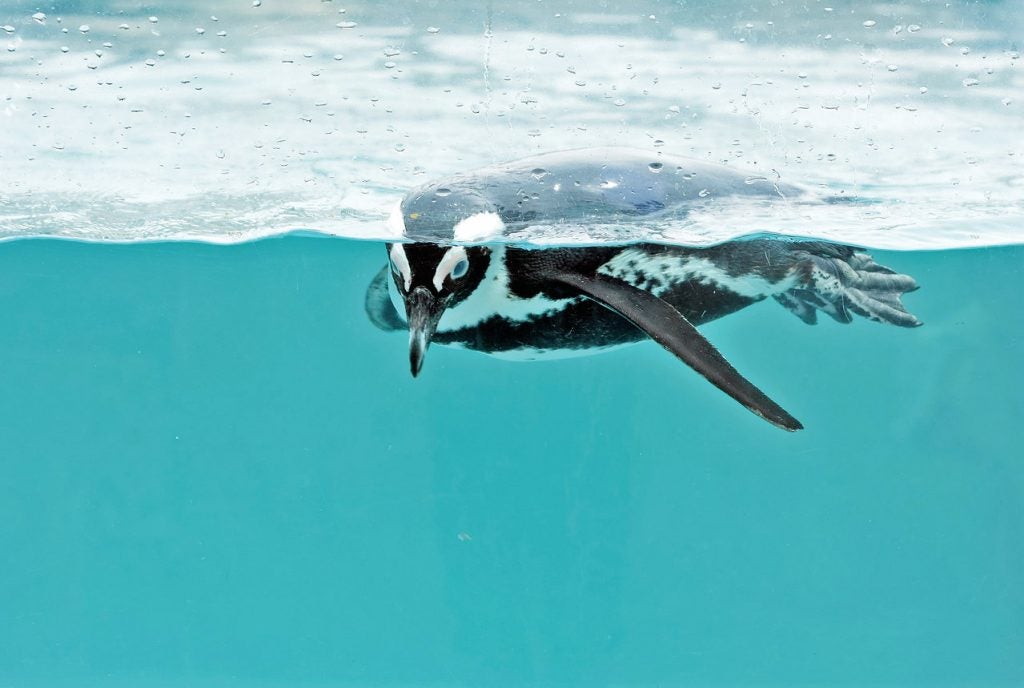
Photo: Courtesy Mystic Aquarium
A bad day at work? Not here.
Not every URI grad who works at the aquarium works with marine mammals, of course. Megan Priede-Sousa ’06, for instance, is the assistant supervisor of fish and invertebrates, which means she is responsible for almost everything that has to do with the aquarium’s marine life— with the exception of the birds, mammals, and reptiles.
And Tyler Bawden ’17 helps ensure that visitors to the aquarium have a positive experience. As a guest services captain, he answers questions from guests, ensures exhibits are staffed, helps run the shows, trains new staff, and handles guest complaints. It’s exactly the kind of job he hoped for when he earned his degree in wildlife biology—a combination of wildlife conservation and environmental
education.
“Every day working with guests and animals is strangely unique,” he says. “All the animals have as many personalities as our staff does, and our guests can make or break the day. We have a really good team that helps support whatever comes our way, from making sure our shows open up, telling people about feeding times, wandering around addressing issues, and making sure the front desk is taken care of. If something doesn’t seem right, we work on it.”
While he doesn’t get hands-on with the animals every day, he helps manage VIP tours and beluga whale encounters, and he gets plenty of opportunities for wildlife encounters of his own.
“Everything is so unique here,” Bawden says. “On any given day I might want to hang out with the fur seals or be surrounded by the reptiles—they’re my bread-and-butter. I can’t say I have a favorite animal, but I also don’t have a least favorite.”
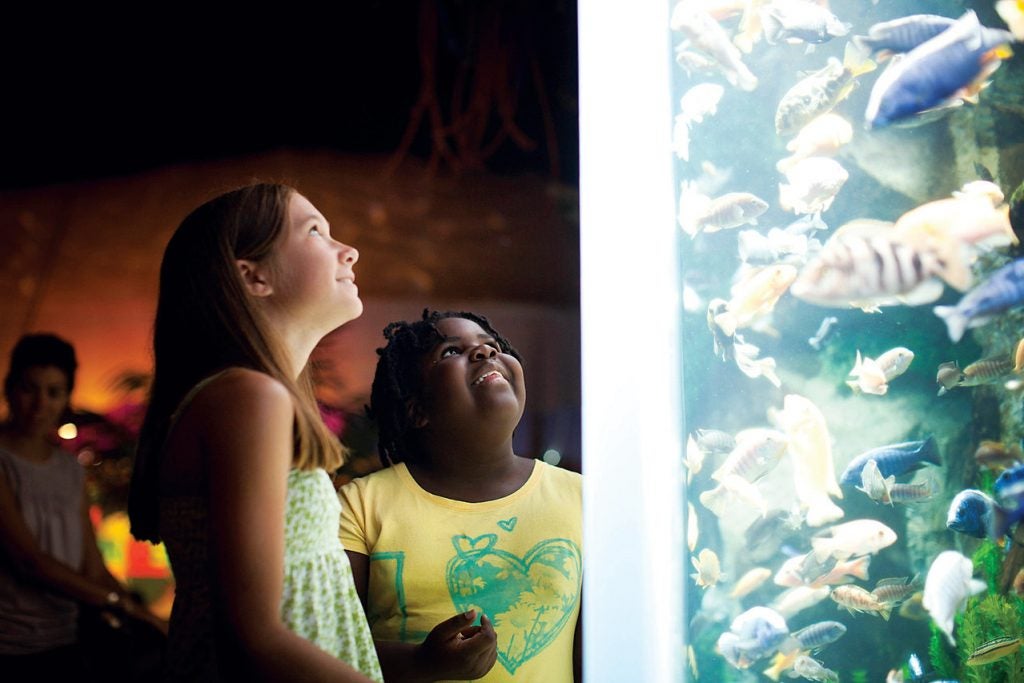
Photo: Courtesy Mystic Aquarium
For Gabby Woodford ’14, working at the aquarium often means she’s on the road presenting educational programs about marine life to audiences near and far, all of which involve showcasing some of the aquarium’s animals, from crabs to sea urchins to reptiles.
“I could be doing a birthday party at the aquarium or at someone’s house; I might go to a school and do multiple programs in one day; or bring a touch-tank to a conference; or take people on tours,” she says. “We even have weeklong programs sometimes.”
“If people don’t know about an animal, they don’t know to care about it. So education is the most important part of conservation.”
–Gabby Woodford ’14
She enjoyed the fieldwork she conducted while earning her wildlife biology degree, including searching for salamanders in West Virginia, conducting an inventory of reptiles and amphibians on Fire Island National Seashore, and learning to track birds by first tracking her professor through the woods. But when it came time to look for a job, she was most interested in those that featured environmental education.
“If people don’t know about an animal, they don’t know to care about it,” says Woodford. “So education is the most important part of conservation. It’s especially fun for me to watch kids learn about why it’s so important to protect these animals.”
“It’s really hard to have a bad day when you’re out there and you get to see beluga whales and sea lions every day,” concludes Quirke. “There’s a lot of hard work going on behind the scenes to take care of all of the animals, but all that hard work is absolutely worth it.” •
Understanding Beluga Reproduction
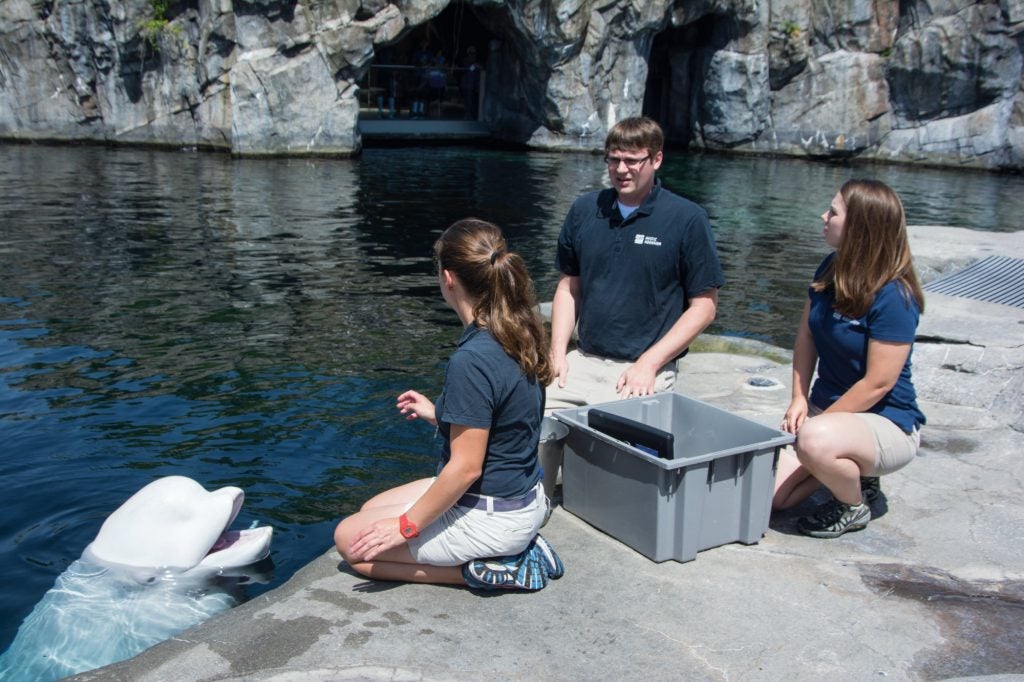
Justin Richard’s experience at Mystic Aquarium extends beyond his former career working with beluga whales and his present role co-teaching the marine mammal seminar. He also conducts beluga whale research at the aquarium, and since 2013, more than 35 URI students have been part of his research team.
He became interested in learning more about beluga reproductive physiology after working with one of the whales that was involved in the first-ever artificial insemination of a beluga.
“I realized that little was known about beluga reproduction, and there was a lot that Mystic’s animals could teach us about it,” he says. “There is a very clear connection between understanding beluga reproduction and understanding their population dynamics in the wild. If we’re going to understand how populations grow, we have to understand their reproduction.”
That led him to collaborate with Becky Sartini, associate professor of animal science and an expert in mammalian reproductive physiology.
“Studying Mystic’s belugas year-round helps us fill in the knowledge gaps that studying them in the wild leaves, because the animals breed in the late winter in the Arctic when they’re completely inaccessible,” Richard says.
He has spent the last five years validating methods of measuring reproductive hormones. For instance, he figured out he could identify when female whales have ovulated and the status of their pregnancy from hormones in the mucus from their exhalation or blow. He has also validated the use of ultrasound to assess male reproductive physiology.
There is a lot that Mystic’s animals can teach us about beluga reproduction. “There is a very clear connection between understanding beluga reproduction and understanding their population dynamics in the wild.”
–Justin Richard, Ph.D. ’16
Now he’s trying to link behavioral observations with these physiological measures so he can determine a whale’s reproductive status based entirely on the behaviors they exhibit.
“They’re very showy animals, almost like birds, in that the males perform a lot of display behaviors, which suggests that the females are choosy about who they mate with,” he says. “And that leads to many different management and conservation questions, especially as beluga habitat changed rapidly with the loss of Arctic sea ice.” •
